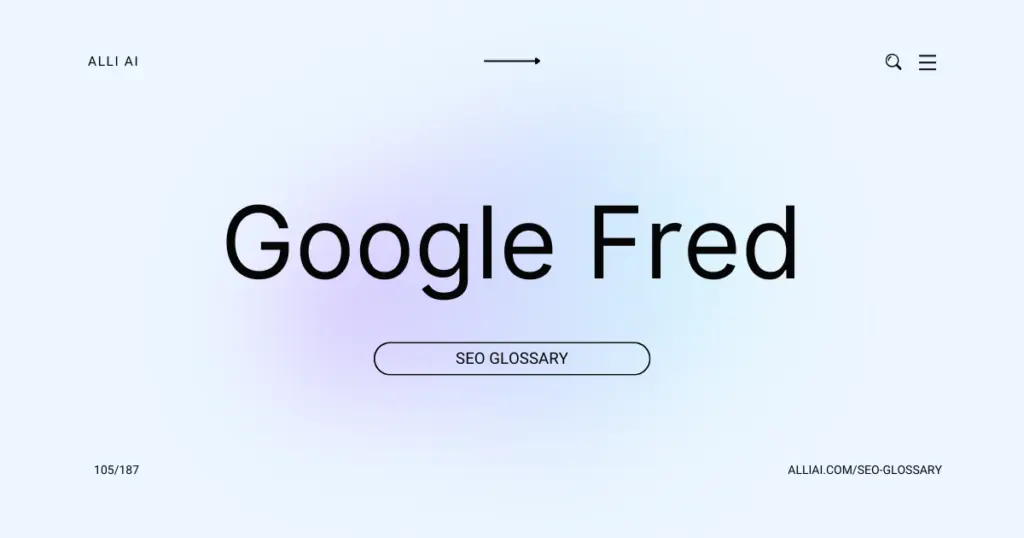What Does Google Fred Mean?
Google Fred is an unofficial name for a series of Google search engine updates that started in March 2017. These updates target websites that violate Google’s webmaster guidelines, particularly those with low-quality content or ones that prioritize monetization (through excessive ads or affiliate links) over user experience. The main goal of Google Fred is to improve the quality of search results by penalizing or decreasing the rankings of these low-quality sites.
Where Does Google Fred Fit Into The Broader SEO Landscape?
Google Fred is an unofficial name given to a series of updates that Google rolled out, which first came to prominence in March 2017. These updates targeted websites that were violating Google’s webmaster guidelines. The primary focus was on penalizing sites that prioritized revenue above user experience. Sites affected by Fred were typically those with low-quality content that were overloaded with ads or affiliate links. Fred fits into the broader SEO landscape as it emphasizes the importance of high-quality content and good user experience, discouraging practices that solely aim at generating ad revenue without offering real value to users.
Real Life Analogies or Metaphors to Explain Google Fred
1. Google Fred is like a teacher’s red pen: Just as a teacher uses a red pen to mark and correct errors in students’ assignments, Google Fred targets and penalizes websites that fail to meet quality guidelines, focusing on enhancing the overall content quality online.
2. Google Fred as a neighborhood watch: Imagine Google Fred as a neighborhood watch program, keenly observing each house (website) in the neighborhood (internet). It ensures that all houses abide by the community rules (Google’s guidelines), particularly those trying to bend the rules for personal gain.
3. Google Fred as a fitness coach: Like a fitness coach who pushes athletes to follow best practices for optimal performance and penalizes shortcuts like using banned substances, Google Fred pushes websites to adhere to best SEO practices and penalizes those employing black-hat techniques to artificially boost rankings.
4. Google Fred as a filter in a fish tank: Consider Fred as a crucial filter in a large fish tank, responsible for keeping the ecosystem clean and balanced. It filters out the pollutants (low-quality content and unethical SEO practices), ensuring that only clean, healthy water (high-quality, user-friendly websites) circulates.
5. Google Fred as a game referee: Think of Fred as a referee in a basketball game, ensuring that all players follow the rules. When a player commits a foul (uses techniques against Google’s guidelines), the referee (Fred) is there to call it out and award penalties, maintaining fairness and integrity in the game (search results).
These analogies or metaphors help in understanding the pivotal role of Google Fred in maintaining the quality and fairness of the digital information landscape, much like various roles and systems maintain quality and order in other areas of life.
How the Google Fred Functions or is Implemented?
Google Fred is not a single algorithm update but a reference to a series of updates aimed at targeting low-quality content and black-hat SEO tactics. It focuses on:
1. Content Quality: Penalizes thin, affiliate-heavy, or ad-centered content that provides little user value.
2. User Engagement Metrics: Sites with poor user engagement metrics (high bounce rates, low time on site) suggest low-quality content, impacting rankings.
3. Backlink Quality: Devalues sites with a non-natural backlink profile, such as those with links from low-quality or irrelevant sites.
4. Ad-to-Content Ratio: High ratios of ads to content can trigger penalties, particularly if the ads are obtrusive or detract from the user experience.
5. Keyword Stuffing: Penalizes over-optimization of content with excessive use of target keywords.
6. Hidden Text and Links: Discourages using text and links that are the same color as the background, positioning text off-screen, setting font size to zero, or hiding links within small characters.
7. Page Layout: The layout that pushes content below the fold in favor of advertisements also comes under scrutiny.
8. Mobile Friendliness: Sites not optimized for mobile viewing could be penalized, emphasizing mobile-first indexing.
9. Page Speed: Slow-loading sites can negatively affect rankings, especially on mobile searches.
Google Fred targets to enhance the overall search experience by ensuring that high-quality, useful, and relevant content ranks higher, while penalizing sites that focus solely on revenue generation at the expense of user experience.
Impact Google Fred has on SEO
Google Fred targets websites that violate Google’s webmaster guidelines by aggressively focusing on aggressive monetization at the expense of good user experience. Websites affected by Fred are typically those with low-quality content that is often overloaded with ads, affiliate links, and does not provide genuine value to the audience. This results in a significant drop in search rankings for impacted sites, thereby reducing their visibility and organic search traffic. Additionally, user experience is negatively impacted as these sites usually prioritize revenue generation over fulfilling the needs and expectations of visitors, leading to poor engagement and higher bounce rates. Consequently, adhering to quality content standards and optimizing for user experience is essential to mitigate the risks associated with Google Fred.
SEO Best Practices For Google Fred
1. Audit your website to identify any violations of Google’s webmaster guidelines, focusing on aggressive monetization techniques, low-quality content, and user experience barriers.
2. Improve content quality by ensuring all pages provide real value to users, are well-researched, informative, and free from spelling and grammar errors. Remove or rewrite thin content that fails to provide useful information.
3. Increase user engagement by improving website layout and navigation, ensuring it’s easy for visitors to find relevant information quickly.
4. Reduce the number of ads on your site, particularly those that are intrusive or detract from the user experience. Place ads thoughtfully, ensuring they don’t interfere with content consumption.
5. Enhance page speed through optimization techniques such as compressing images, leveraging browser caching, and minifying CSS, JavaScript, and HTML.
6. Ensure your website is mobile-friendly by adopting responsive web design, optimizing images, and improving mobile load times.
7. Secure your website by migrating to HTTPS if you haven’t already, as this is a ranking signal and crucial for user trust.
8. Generate high-quality backlinks from reputable, relevant sources to improve domain authority and trustworthiness rather than relying on purchased or low-quality links.
9. Continuously monitor your site’s performance through tools like Google Search Console and Google Analytics to understand how users are interacting with your site and to detect any penalties quickly.
10. Update content regularly to keep it fresh and relevant, ensuring that all information is current and reflects the latest trends and data in your industry.
Common Mistakes To Avoid
1. Low-Quality Content: Google Fred targets low-quality content that appears created solely for generating ad revenue. Avoid this by focusing on high-quality, relevant, and informative content that provides real value to your audience.
2. Keyword Stuffing: Overusing keywords to manipulate rankings can trigger Fred’s penalties. Ensure content remains natural and uses keywords contextually.
3. Aggressive Monetization: Excessive ads or affiliate links that impair user experience can be penalized. Limit the number of ads and ensure they don’t interfere with content navigation and readability.
4. Poor User Experience (UX): Websites that offer a bad user experience, especially those cluttered with ads, are likely targets. Invest in good design, user-friendly navigation, and responsiveness.
5. Thin Content: Pages with little or no original content can be seen as less valuable. Create detailed and substantial content that addresses user needs and queries thoroughly.
6. Unnatural Backlinks: Avoid schemes like purchasing links or participating in link exchanges. These can be seen as attempts to manipulate page rankings.
7. Cloaking and Sneaky Redirects: Implementing deceptive techniques like cloaking or sneaky redirects can lead to Fred penalties. Always be transparent and straightforward with your SEO tactics.
8. Overuse of Affiliate Links: While not bad in moderation, overuse or poorly integrated affiliate links can be penalized. Use them sparingly and ensure they fit naturally within your content.
By addressing these issues directly and consistently focusing on enhancing user experience and content quality, websites can mitigate the risks associated with Google Fred and other similar algorithm updates.






